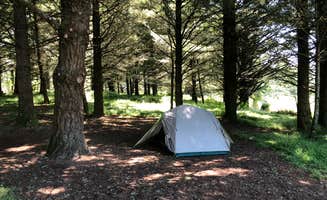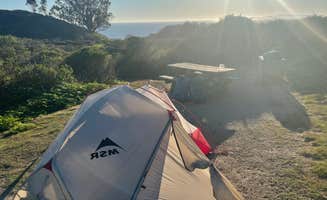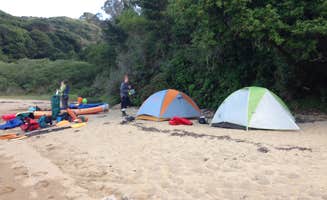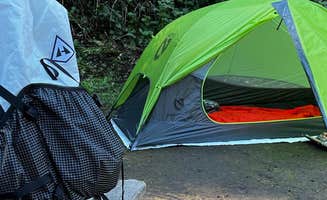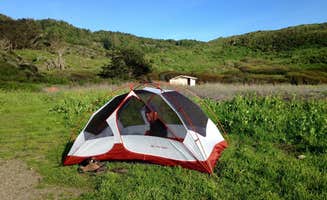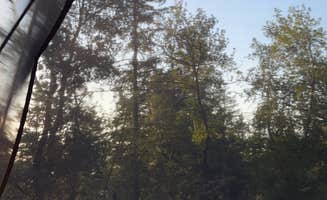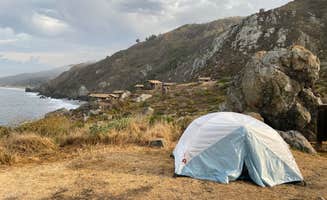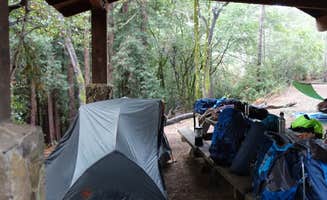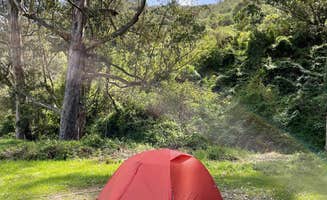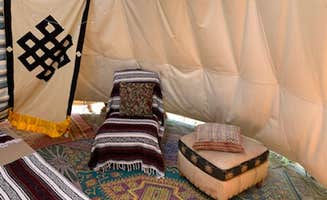Tent camping around Inverness, California centers on the Point Reyes National Seashore, where campsites sit at elevations between 150-1,000 feet with morning temperatures often dropping into the 40s even during summer months. The region experiences distinct microclimates where inland campsites can be sunny while coastal sites remain shrouded in fog. Most walk-in campgrounds require between 1.3-6.3 miles of hiking to reach established sites.
What to do
Beach exploration: From Coast Campground, campers can access miles of undeveloped shoreline. "The beach was sandy and beautiful, not that many people around," notes Char A., who visited in February and found temperatures ranging from 38-70°F.
Tidepooling opportunities: Marine life viewing is accessible from several Point Reyes campsites. At Tomales Bay Boat-In Camping, visitors report seeing "sea jellies, bat rays, maybe a leopard shark, and bioluminescent plankton" according to Deanna K., who recommends slowing down "near weedy shores to look for jellies and sting rays."
Waterfall hiking: Several accessible cascades can be reached from campgrounds. "The hike to the campgrounds from the Bear Valley Visitors Center is about 2-3.5 miles depending on the route," notes Gustavo M. about Sky Campground, which serves as a good base for waterfall exploration.
Forest exploration: The area offers diverse ecosystems within short distances. "We visited during a rain storm so there were waterfalls everywhere," reports Nikki T. about trails near Alice Eastwood Group Camp, noting the "gorgeous" surroundings.
What campers like
Diverse terrain: Campers appreciate the variety of landscapes within hiking distance. "The trail is largely up on the bluffs above the coast, with killer views. Good place to see whales. Halfway there, the trail goes inland and passes a bunch of little lakes," explains Valerie T. about the route to Wildcat Campground.
Privacy between sites: Many campsites offer separation despite proximity. "The tall grass gave some privacy between neighboring campsites," notes Taylor A. about Wildcat Campground, which features open meadow camping just yards from the beach.
Bioluminescent viewing: Evening water activities are popular at certain sites. "If you plan it right, you may catch a bioluminescence show in the water once the sun sets (plan for new moon times)," advises Tiffany F. about kayak camping along Tomales Bay, recommending launching from Miller Boat Launch in Marshall.
Stargazing opportunities: Clear nights offer exceptional celestial viewing. "The sky at night is ideally suited for star gazing since the north bay doesn't get as much fog as the general SF bay area and the city lights don't pollute the night sky too bad," explains Patrick O. about camping near the coast.
What you should know
Limited water access: Some campgrounds require bringing your own supply. "No water. We backpacked in from the Golden Gate Bridge. There was no place nearby to fill up on water, and had to be extremely conservative in our use," warns Erin S. about Haypress Campground.
Wind exposure: Coastal sites face regular strong breezes. "It can get windy in summer. Fall is best. For privacy, book a site out of the meadow," advises J.d. E. about Coast Camp, noting the advantage of protected sites.
Wildlife concerns: Small animals frequently visit campsites. "You might want to be on the lookout for small vermin running around the fields and looking to snag any food you've left out," cautions Elliott B. about Wildcat Campground, recommending secure food storage.
Reservation challenges: Most sites require advance planning. "These are sites are in high demand, but totally worth the wait to experience," shares Sara S. about Wildcat Campground, noting the lengthy hike doesn't detract from the experience.
Tips for camping with families
Beginner-friendly options: Some shorter hikes work well for children's first backpacking experiences. "This was our first backpacking trip and we mostly wanted to test our gear. This was perfect for that. 5-mile hike in with some uphill in the last 1.5 miles that was challenging but not too hard," explains Emily A. about her experience at Glen Campground.
Beach camping with kids: Coastal sites offer play opportunities. "We went for two nights on 02/28. Got a permit for a beach fire but couldn't find enough drift wood to make it last. Wonderful campsite though, can't beat our view and sounds of the ocean," shares Char A. about Coast Campground.
Protected swimming locations: Inland water spots provide safer swimming. "Bass lake off to the left is a great swimming hole. Nice lunch stop," recommends Valerie T. about the lake along the trail to Wildcat Campground.
Accessible wildlife viewing: Marine mammal sightings delight children. "The seashore was awesome and we saw lots of elephant seals having a noisy morning," notes Cierra A. about her experience near Sky Campground.
Tips from RVers
Alternative tent camping for RVers: Bootjack Campground provides accessible tent options for RV travelers wanting to experience tent camping Inverness, California. "We originally arrived at bootjack thinking we could drive directly to our campsite and car camp... unfortunately you cannot. However, thankfully we brought a tent!! The sites are very close to the parking lot so it was easy to haul everything up and back from the car," explains rylee.
Site separation considerations: Some sites offer more privacy than others. "Some of the sites are two levels. Many are next to the creek. It's usually quiet and peaceful," notes R D. about Bootjack Campground, adding that "maximum stay 14 nights per year."
Weather preparation: Temperature fluctuations affect comfort levels. "Bring some steel wool or a critter-proof container to keep food safe, even inside the locker," advises Michael I. about preparing for small rodents at Wildcat Camp, noting the temperature variations between sites.


